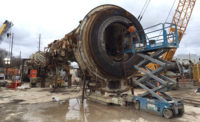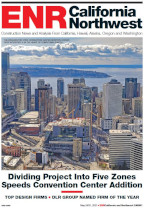Still, upgrading a two-lane highway with 16 signaled, full-access intersections to a mostly three-lane, limited-access freeway with 11 grade-separated interchanges—thus allowing the free flow of mainline traffic without stoplights—is believed to be the largest-ever road project undertaken in Hamilton County. The corridor is home to major area hospitals, national corporations, such as Delta Faucet Co., as well as well-heeled residential and recreational developments.
At the project's southernmost point, U.S. 31 takes over from Meridian Street at an Interstate 465 interchange and cuts through the affluent suburbs of Carmel and Westfield to State Road 38, where the scope of this project ends. The highway continues north to Kokomo, South Bend and eventually into Michigan. Building the Carmel section is a joint venture between local firms E&B Paving of Anderson and Gradex of Indianapolis. The venture holds a $141-million contract to rebuild the I-465 interchange, including two flyover ramps, and construct four new roundabout interchanges. In an effort to accelerate construction of bridges and other structures, the central section of the Carmel project closed in April 2014 and reopened seven months later and remains the only mainline closure.
Road builder Rieth-Riley holds four other large contracts that upgrade U.S. 31 through Westfield. Valued collectively at another $141 million, the work includes bridges, roundabouts, a split-diamond interchange and a single-point urban interchange at S.R. 38. Grade separations call for mechanically stabilized earth walls and architectural precast concrete panels, the hauling of which posed challenges due to tight jobsite space.
"Access was tough," says Mike Jaskela, senior project manager for Goshen, Ind.-based Rieth-Riley. "We ended up with a lot of sandbox areas that presented access issues." Hauling earth, aggregate, concrete panels, steel and asphalt—the 12.75-in.-thick, full-depth pavement through Westfield will on its own consume some 300,000 tons of hot mix—has tested the local trucking market, Nierman adds.
"We still have 500,000 cubic yards of structural backfill material left to build MSE walls," he explains. "Just the sheer volume of those materials becomes a logistics issue to come up with enough truck drivers to get the materials in and out at the required pace."
Considering the extra work—and cost—it takes to separate grades, remove stoplights, build roundabouts and reroute traffic in this way, one wonders if U.S. 31 will serve as a model for future projects in the Hoosier State. With no more toll roads to lease, capital could be scarce, Rowley notes. "Had the funds not been there, probably they would have continued to widen the lanes," he says. On the other hand, Jaskela observes that Indiana is reaching out to the private sector for financing—such as for planned additions to Interstate 69—and several design-build projects coming in the area "are enough to keep all the equipment we've purchased and people busy."








Post a comment to this article
Report Abusive Comment